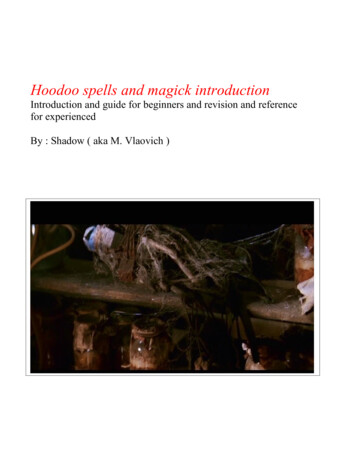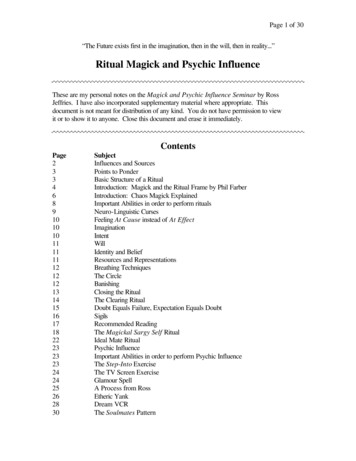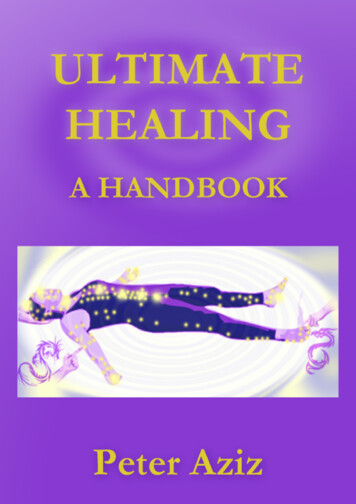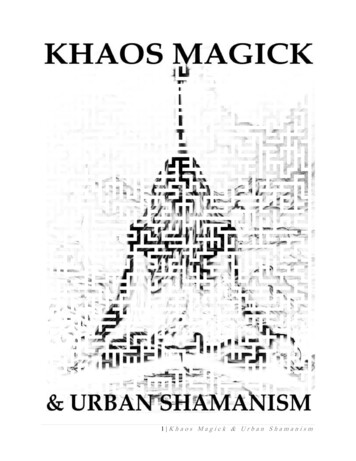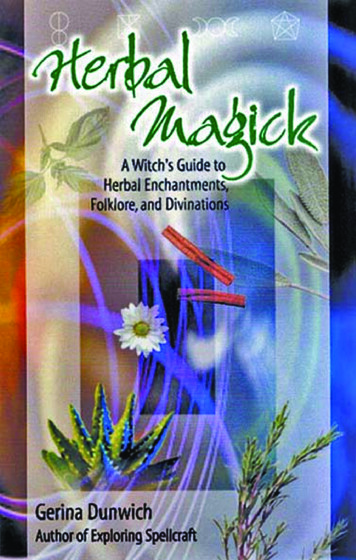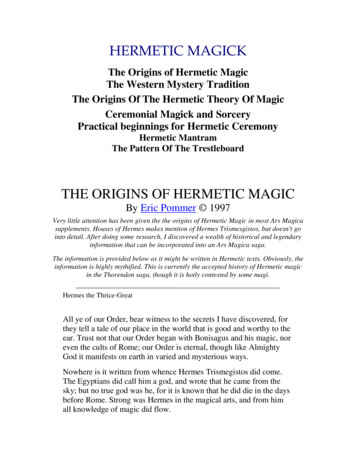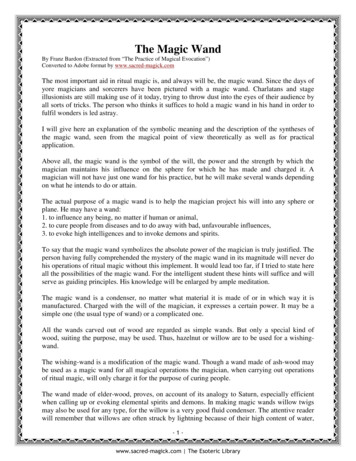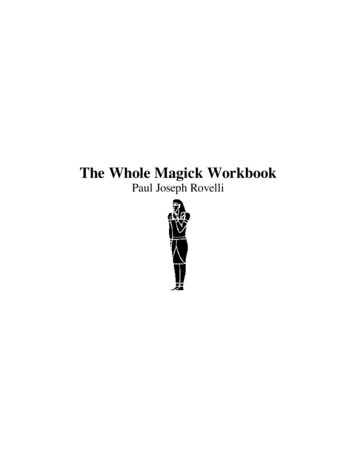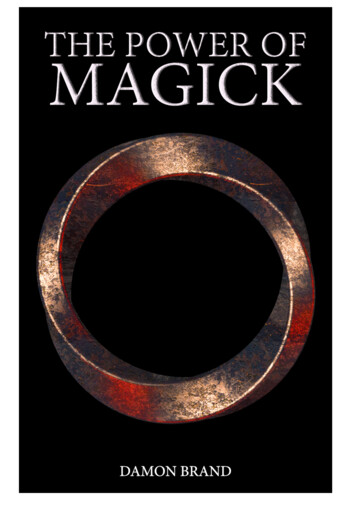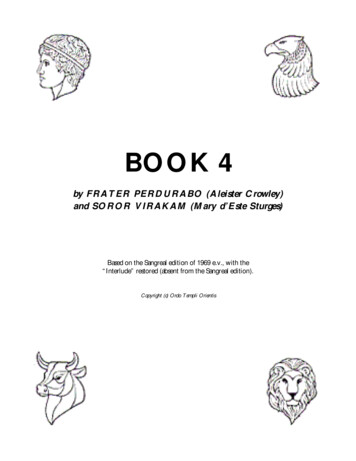
Transcription
About the AuthorPhilip H. Farber (New York’s Hudson Valley) is a respectedauthor andmagician who teaches at Maybe Logic Academy. Acertified hypnotist, hypnotistinstructor, and licensed NLPtrainer, Farber has written three books onmagick. Visit himonline at Meta-Magick.com.
Llewellyn PublicationsWoodbury, MinnesotaCopyright InformationBrain Magick: Exercises in Meta-Magick and Invocation
2011 by Philip H. Farber.All rights reserved. No part of this book may be used orreproduced in any matter whatsoever, including Internet usage,without written permission from Llewellyn Publications, exceptin the form of brief quotations embodied in critical articles andreviews.As the purchaser of this e-book, you are granted the nonexclusive, non-transferable right to access and read the text ofthis ebook on screen. The text may not be otherwise reproduced,transmitted, downloaded, or recorded on any other storagedevice in any form or by any means.Any unauthorized usage of the text without express writtenpermission of the publisher is a violation of the author’scopyright and is illegal and punishable by law.First e-book edition 2011E-book ISBN: 9780738729770
Book design by Bob GaulCover art Neuron: iStockphoto.com/Sebastian Kaulitzki,Ancient Script: iStockphoto.com/Christian MisjeCover design by Ellen LawsonEditing by Ed DayLlewellyn Publications is an imprint of Llewellyn WorldwideLtd.Llewellyn Publications does not participate in, endorse, or haveany authority or responsibility concerning private businessarrangements between our authors and the public.Any Internet references contained in this work are current atpublication time, but the publisher cannot guarantee that aspecific reference will continue or be maintained. Please refer tothe publisher’s website for links to current author websites.Llewellyn PublicationsLlewellyn Worldwide Ltd.2143 Wooddale DriveWoodbury, MN 55125www.llewellyn.comManufactured in the United States of America
To Atem: We give you attention, language,To Atem: We give you attention, language,passion, fitting, trance, and making.You give us the gods.Contents
Introduction1. States of Consciousness2. Form and Content3. Invocation and Evocation4. Mirror Realities5. Tingling and Sparkling6. Stepping In7. Elementary Ritual8. The Mastery Technique9. The Time Axis10. Shaping the Cloud11. Permanent Woohoo12. The Group Mind13. Speculation14. The Way of WoohooAppendix One: SexAppendix Two: DrugsAppendix Three: Rock and RolGlossaryNotes
Bibliography
IntroductionThe Way of WoohooConsider the possibility of a full-sensory story, something like amotion picture, only more so, or like virtual reality, only evenricher in information. The story is created from real perception—things that you can see, hear, touch, taste, and smell. Perceptionsand states of consciousness flow into a kind of narrative, notnecessarily in a straight line, more a sort of cloud or swarm,vaguely organized—though not always—along an axis of time.Even in that disorganization, the flow of attention, the part of theplot we follow through the swarm, may zig and zag from anyperception to almost any other, the entirety of the story onlybecoming clear after we have partaken of thousands andthousands of memories, feelings, and experiences.It’s the ultimate medium: a palette of every color, sound,feeling, scent, and flavor. It can be populated with multitudes ofcharacters—family, friends, lovers, teachers, neighbors,strangers, good guys, bad guys, heroes, schmucks, and everyoneelse. It can be beautifully simple or complex beyond therendering of any supercomputer. If you were the author of this
amazing, full-sensory story, think about the kinds of choices youcould make. When the plot arc, the scope of the tale, finally risesinto view, just what kind of story do you hope it will be?There are billions of people with access to this excitingmedium—but only some of them even realize that they are theauthors, the directors, and the producers of their own fullsensory story. Shakespeare told us that we are but players; whathe failed to mention is that, like him, we can also turn the taletoward our own aesthetic ends. Of the few humans who eventhink about their world enough to realize their own artisticcontrol, only a few have figured out the techniques. The result isthat many of the full-sensory stories out there—billions of them—really suck. Or, for the most part, they are repetitive,predictable, and unremarkable lives based around B-movie (orworse!) plots.The question then becomes—how much do you want yourown story to really rock? How exquisite, grand, powerful,intriguing, seductive, exciting, or mythic would you like yourexperience to be? What excites your neurons, strokes your senseof aesthetics, fulfills your philosophy, applies significance toyour circumstance, or makes you scream and shout? Whatever it
is that puts the sauce on the omelet, the brushstroke to the StarryNight, the bubbles in the Jacuzzi, the ecstasy in viewing a bluearc of summer sky, we shall refer to here as woohoo.arc of summer sky, we shall refer to here as woohoo.Woohoo is the subtle difference between ordinary andexciting, the factor that makes just another stranger into yourfriend, your teacher, or your lover. Woohoo is what turns anactivity into a passion; it’s what changes noise into song, footmovement into dance, travel into adventure, procreation intoeros, and biological processes into a life worth living. Woohoo isthe measure of intensity. It’s what continues to draw yourattention, moment after moment. It’s what makes a feeling worthhaving. Like the Tao, true woohoo has no definite form. Yourpersonal way of woohoo cannot be named; it is a flow ofexperience that changes from moment to moment.Woohoo can be thought of as more of a how than a what. Acamera angle may make the difference between a home videoand awe-inspiring cinematography. A nuance of pitch or timbremight separate a technically correct piano recital from a heartfeltvirtuoso performance. Duration and subtlety of movement mightmake the difference between a goodnight kiss and an exciting
erotic invitation. How we perceive may determine the quality ofwoohoo as much as what we perceive the content of thatexperience. The way that we process our sensory input includes,somewhere along the way, the decision to put our inner artist towork, for our brains to portray our experience with the rightcamera angle, the sweetest emphasis of tone, or with eroticsubtlety. That decision, to woohoo or not to woohoo, usuallyhappens outside of our conscious awareness. We can, however,make it a conscious choice.The pursuit of a woohoo-filled life story, whatever the detailsof that might be for you, is the Way of Woohoo.The Model of Meta-MagickMagick, as we’re using the term here, refers to a means of firstperfecting the self so that the things that one may do will bedone with power and effectiveness. This has always been theaim of magick—to understand the relationship betweenconsciousness and the world in a way that allows us to re-createourselves (and our world) in hedonic, healthy, and practicalways. Our understanding and self-perfection allow us to fit intothe world so well that we can influence it in accordance with ourwill.
Meta-Magick is a collection of opportunities to think aboutmagick. Elements from a variety of theories and models, rangingfrom neuroscience to voodoo, are offered as clues to understandthe phenomena we find in our magical experiments. There aremany different styles and practices of magick, in every culture,many different styles and practices of magick, in every culture,on every continent. By identifying some of the commonelements, we are better able to separate out the magick itself, thetechniques and practices that really work, from the content of therituals that relates to specific belief systems. In general, manytechniques of magick are the same everywhere, with their intentaimed at different results and deities. This suggests that therituals and practices derive from the commonality of humanexperience; this is how our brains work when we do magick.Our focus will be on the magical operation of invocation. Ifyou are already familiar with magick and invocation techniques,you may be able to use the exercises in this book to identify thebehaviors and experiences that make those techniques effectivefor you. If you are completely new to these concepts (relax, allwill be explained soon.), you can use the methods given here asbuilding blocks for your own techniques and magical rituals.
We’ll start with a premise that magick is, at least in oneimportant way, like every other human behavior: it derives fromthe interplay of our mind/body and the world. Anything that wecan do, magically or otherwise, will be represented bycorresponding processes in our brains, our bodies, and ourbehavior. While that may not be all that happens, it offers usimportant clues to how we can replicate magical results andutilize the tools that we have—our perceptions and abilities.Two questions to keep in mind while experimenting with thisbook are: “Which of my behaviors contribute to makingmagick?” and “How can I use those behaviors to createmaximum woohoo in my life?”Experimental results will undoubtedly differ from person toperson. Ultimately, the model of magick and the direction thatyou take toward increased woohoo can be unique to you. Thereare no right or wrong results for any of the experiments.Whatever happens becomes data for your own map to the realmof woohoo. In short, this is magick about magick, rituals andtechniques designed to help us understand more about ritualsand magical techniques. When we begin to work with othersand compare results, we may be able to create more generalized
models of magick.Meta-Magick exercises can be practiced as a separate systemof magick; however, it is just as interesting to apply the insightsgained from this exploration to a practice or system you mayalready be familiar with. Or use these techniques to developyour own, personal system of magick from scratch. Or find thewoohoo wherever it may lie and gather it into everything yousee, hear, feel, taste, and smell throughout your life. In short, usesee, hear, feel, taste, and smell throughout your life. In short, usethis book to bring some woohoo to whatever you do.The Model of ScienceThink of science, like Meta-Magick, as a means for creatingmodels. An all-too-common perception of science is that it dealsin authoritative facts—truths that are immutably recorded inpeer-reviewed journals and blessed by academia. In actuality,science is a method of inquiry that generates theories. Theoriesare forms of metaphor that explain a body of data, althoughscientists often may shy away from admitting the metaphoricquality. Metaphors are rarely perfect and almost always leave alot of room for interpretation. Theories are updated, hopefully ona regular basis, to best fit the map of the world we operate from.
The bits and pieces of neuroscience that illustrate the ideas inthis book are by no means definitive—and it is likely that myinterpretation of those bits and pieces may be quite differentfrom that of the scientists who proposed them. As this is a bookabout the magical art of invocation, not neuroscience, we willexplore only a tiny portion of the huge and complex subject ofthe human brain. This is done as a way of building operatingmetaphors and not, by any means, a complete or necessarily“true” map of neurological functions. These theories can helpdevelop the hypotheses that we use to initiate our experimentsand, as “operating metaphors,” they help build a frame throughwhich to view and understand our responses.The more important parts of this book, the exercises, providea framework for creating experiments. Consider yourexplorations of woohoo as a process of personal scientificinquiry, with your own consciousness as laboratory. For thosenot already familiar with scientific method, the steps are fairlysimple:1. The scientist creates a hypothesis. A hypothesis is aneducated guess at an outcome that we can test with anexperiment. For instance, “If I read this book and
practice the exercises, I’ll learn something about magickand the brain.”2. An experiment is designed to test the hypothesis. In thiscase, the experiment might be actually reading the bookand practicing the exercises, and then testing yourknowledge of magick against what it was prior toreading and practicing.3. After repeated experiments—perhaps involving otherpeople reading and practicing, or perhaps reading andpracticing from other magick books—a theory can bepracticing from other magick books—a theory can beformed. The theory might be a denial or confirmation ofthe hypothesis, or it might be something else entirely,deduced from the experience.In short, I hope that you will be scientific in this personalway, that you will perform the experiments and eventually,when you think you have enough data, draw your ownconclusions about the processes of invocation and the nature ofwoohoo.
Do the experiments and draw your own conclusions.[contents]States ofConsciousnessThe Nature of a StateConsciousness flows, ever-changing, from one moment to thenext. However minutely or broadly, each nanosecond ofexperience differs from the preceding one. When we talk about a“state of consciousness,” we make a generalization about acollection of such moments, that some aspects of consciousnessremain constant, or at least similar, for a period of time. Even so,sensory experience continues its kaleidoscopic change. Whenwe meditate, we ease into a session, first getting comfortable inour posture, then getting into the flow of meditation, then easingback out, aware of comfort or discomfort in our bodies, andturning our attention back outward. Rather than a singular statecalled “meditation,” we may find a continually shiftingexperience—a process rather than a thing. A
About the Author Philip H. Farber (New York’s Hudson Valley) is a respected author andmagician who teaches at Maybe Logic Academy. A certified hypnotist, hypnotistinstructor, and licensed NLP


